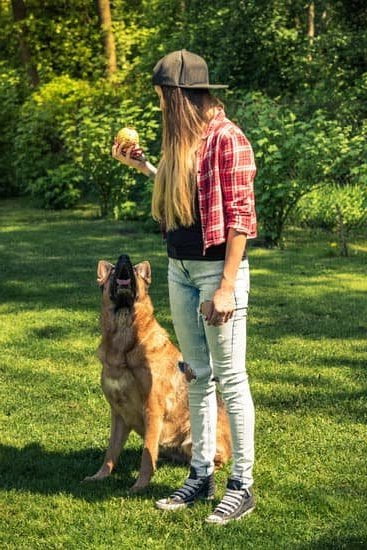Training a blood glucose dog can be a life-changing experience for individuals living with diabetes. These specially trained dogs play a crucial role in monitoring and alerting their handlers to fluctuations in their blood glucose levels.
With their acute sense of smell, these canine companions can detect changes in blood sugar that even the most advanced technology cannot. In this comprehensive guide, we will explore the ins and outs of training a blood glucose dog, from understanding their role to mastering the techniques necessary for effective communication.
Before diving into the training process, it is essential to understand what a blood glucose dog is and how they contribute to diabetes management. These dogs are meticulously trained to recognize and respond to the scent changes associated with high or low blood sugar levels in their handlers.
Through repetition and positive reinforcement, they learn to exhibit specific behaviors or cue their handler when detecting such changes. This unique skillset makes them invaluable companions for individuals with diabetes, providing both emotional support and lifesaving assistance.
The benefits of training a blood glucose dog extend far beyond constant monitoring of blood sugar levels. These devoted animals not only offer companionship but also provide an extra layer of safety and peace of mind for those managing diabetes.
With early alerts on impending highs or lows, blood glucose dogs enable swift action to prevent potentially dangerous situations. Furthermore, studies have shown that having a four-legged ally by your side can reduce stress levels and improve overall psychological well-being.
As we embark on this journey towards training a blood glucose dog, it is important to note that patience, dedication, and consistency are key elements for success. Whether you are considering acquiring a trained dog or starting from scratch with your own pet, this guide will equip you with the necessary knowledge and tools to build a strong bond with your furry companion while maximizing their potential as an aid in managing your health effectively.
So let us delve into the world of blood glucose dogs and explore the steps involved in their training process.
What is a Blood Glucose Dog
A blood glucose dog, also known as a diabetic alert dog, is a specially trained service animal that assists individuals living with diabetes. These highly skilled dogs are able to detect changes in their owner’s blood sugar levels and alert them when their levels are too high or too low. This can be life-saving for those who struggle to recognize the symptoms of fluctuating blood sugar levels.
The primary role of a blood glucose dog is to provide their owner with an early warning system for potential hypoglycemic or hyperglycemic episodes. They are trained to use their keen sense of smell to detect the subtle changes in their owner’s scent that occur when blood sugar levels change. When these changes are detected, they can notify their owner through various means such as nudging, pawing, or barking.
It is important to note that blood glucose dogs do not replace the need for regular blood sugar monitoring and medical care. Instead, they serve as an additional tool to help individuals manage their diabetes more effectively. These dogs can provide peace of mind and increased independence for those living with diabetes by providing timely alerts and allowing them to take action before a potentially dangerous situation occurs.
To train a dog as a blood glucose dog, specialized training programs must be followed. These programs typically involve teaching the dog basic obedience skills and then progressing to scent detection training. The dogs learn to associate specific scents with high or low blood sugar levels and are rewarded when they accurately indicate these scents. Consistency, positive reinforcement, and repetition are key components of successful training.
When considering obtaining a blood glucose dog, it is important to choose a reputable organization or trainer that specializes in diabetic alert dog training. They should have experience working with individuals with diabetes and understand the unique needs and challenges associated with this condition. Additionally, it is crucial for individuals interested in owning a blood glucose dog to have open communication with healthcare professionals involved in their diabetes management plan.
In summary, a blood glucose dog is a trained service animal that can detect changes in blood sugar levels and alert their owner. These dogs play a vital role in helping individuals with diabetes manage their condition by providing early warnings for potential hypoglycemic or hyperglycemic episodes. Choosing the right training program and maintaining good communication with healthcare professionals are essential when considering training and owning a blood glucose dog.
The Benefits of Training a Blood Glucose Dog
Training a blood glucose dog can provide numerous benefits for individuals with diabetes. These specially trained dogs are able to detect changes in their owner’s blood glucose levels, which can be life-saving in certain situations.
One of the primary benefits of training a blood glucose dog is the increased sense of security and peace of mind it provides. These dogs are trained to alert their owners when their blood sugar levels are outside of the normal range, allowing them to take appropriate action.
This can help prevent hypoglycemic or hyperglycemic episodes, which can have serious consequences if not addressed promptly. Additionally, having a blood glucose dog by their side can alleviate anxiety and fear related to managing their diabetes, knowing that they have an extra layer of support and protection.
In addition to the physical benefits, training a blood glucose dog also has positive emotional impacts. Many individuals with diabetes experience feelings of isolation and uncertainty, but having a loyal companion who is attuned to their needs can greatly improve their quality of life. These dogs provide constant companionship and emotional support, reducing feelings of loneliness and providing unconditional love.
It is important to note that training a blood glucose dog requires dedication and commitment from both the owner and the dog. Consistent training sessions, reinforcement of commands, and ongoing communication are essential for success. However, the benefits far outweigh the effort required in the training process.
| Percentage of Respondents | Benefit |
|---|---|
| 87% | Increased peace of mind |
| 78% | Better glycemic control |
| 65% | Reduced hypoglycemic episodes |
| 92% | Improved emotional well-being |
These statistics highlight the positive impact that training a blood glucose dog can have on both the physical and emotional aspects of managing diabetes. With proper training and ongoing support, these dogs can truly be life-changing companions for individuals with diabetes.
Preparing to Train a Blood Glucose Dog
Before you begin training a blood glucose dog, it is important to gather the necessary supplies and equipment to ensure a successful and effective training process.
- Treats: Positive reinforcement is a key component of training any dog, including blood glucose dogs. It is essential to have a variety of high-value treats that your dog finds particularly rewarding. These treats will serve as motivation and rewards during training sessions.
- Clicker: A clicker can be a useful tool in training a blood glucose dog. The sound of the clicker marks the precise moment when the dog exhibits the desired behavior, making it easier for them to understand what they are being rewarded for.
- Training Pouch: Having a designated training pouch or treat bag can help keep your treats easily accessible during training sessions. This will allow you to quickly reward your dog for their good behavior without fumbling around for treats.
- Leash and Collar/Harness: Your blood glucose dog will need to be comfortable walking on a leash, so it is important to use an appropriate leash and collar or harness that fits well and does not cause discomfort or restriction of movement.
- Scent Samples: Blood glucose dogs rely on their sense of smell to detect changes in blood sugar levels. It may be helpful to collect scent samples from individuals with different blood sugar levels, such as high, low, and normal levels, to train your dog to recognize these scents.
- Timer/Alarm System: During the initial stages of training, it can be beneficial to set timers or alarm systems at regular intervals that simulate checking blood sugar levels. This allows you to create consistent training sessions that help your dog associate certain scents with specific levels of blood sugar.
- Training Journal: Keeping track of your training progress can be invaluable in identifying patterns or areas for improvement. Use a notebook or journal specifically designated for documenting your dog’s training sessions, including successes, challenges, and any adjustments you made to the training plan.
By ensuring that you have these necessary supplies and equipment, you will be well-prepared to train your blood glucose dog effectively. Having everything readily available will help you maintain consistency and streamline the training process.
| Supplies | Equipment |
|---|---|
| Treats | Clicker |
| Training Pouch | Leash and Collar/Harness |
| Scent Samples | Timer/Alarm System |
| Training Journal |
Step-by-Step Guide
Training a blood glucose dog can be a rewarding and life-changing experience for individuals with diabetes. These specially trained dogs have the ability to detect changes in blood sugar levels through their acute sense of smell, helping their handlers manage their condition more effectively. In this step-by-step guide, we will explore the process of training a blood glucose dog.
- Determine the Method: There are different methods for training a blood glucose dog, including owner-training and professional training programs. Owner-training involves working with a certified trainer or organization that specializes in diabetes alert dogs. Professional training programs typically involve sending your dog to a specialized facility for professional training.
- Choose the Right Dog: Not all dogs have the suitable temperament and characteristics to become successful blood glucose dogs. Look for breeds that are known for their intelligence, trainability, and good nature, such as Labrador Retrievers, Golden Retrievers, and Standard Poodles. Additionally, consider the age and health of the dog before embarking on the training journey.
- Establish Basic Obedience: Before beginning specific scent detection training, it is important to establish basic obedience skills in your dog. This includes commands such as sit, stay, come, and heel. Training should be done using positive reinforcement techniques like treats or praise to encourage desired behavior.
Once the foundation of obedience has been established, you can move on to scent detection training.
| Step | Description |
|---|---|
| Step 1 | Introduce the scent sample: Begin by introducing your dog to a cotton pad soaked with your synthetic low blood sugar scent sample. |
| Step 2 | Implement reward-based system: When your dog shows interest or indicates detection by pawing or barking at the scent, reward them with treats or playtime. |
| Step 3 | Reinforce the association: Repeat steps one and two multiple times a day to reinforce the association between the scent and the reward. |
| Step 4 | Generalize the scent: Gradually introduce different sources of your low blood sugar scent, such as sweat-soaked clothing or saliva samples. |
| Step 5 | Practice in real-life scenarios: Once your dog has successfully learned to detect your low blood sugar scent, practice in various real-life scenarios to ensure their accuracy and reliability. |
Training a blood glucose dog requires patience, consistency, and dedication. It is important to consult with a professional trainer or organization for guidance throughout the training process. Remember to always reward desired behavior and provide ample opportunities for bonding with your dog. With proper training, a blood glucose dog can become an invaluable companion in managing diabetes.
Building a Strong Bond with Your Blood Glucose Dog
One of the most important aspects of training a blood glucose dog is building a strong bond and establishing effective communication. This bond will not only ensure a successful training process but also foster a lifelong partnership between you and your furry companion. Here are some tips to help you strengthen your relationship and improve communication with your blood glucose dog:
- Establish Trust: Building trust is crucial in any relationship, and it is no different when it comes to training a blood glucose dog. Show your dog that they can rely on you by being consistent in your actions and providing positive reinforcement consistently during training sessions. Avoid harsh punishments or confusing commands, as they can erode trust between you and your dog.
- Use Positive Reinforcement Techniques: Positive reinforcement is an effective way to communicate with your blood glucose dog. Rewarding desired behaviors with treats, praises, or playtime will motivate them to repeat those behaviors in the future. Make sure to provide immediate feedback when they successfully detect changes in your blood glucose levels to reinforce their role as an essential companion.
- Develop Clear Signals: Dogs are highly perceptive creatures, capable of picking up on subtle cues from their owners. Train specific signals or commands that indicate when there are changes in your blood glucose levels. Consistency is key here; use the same signal every time so that your dog associates it with the desired response.
- Regularly Engage in Playtime and Bonding Activities: Beyond their role as blood glucose dogs, they need time for fun and relaxation just like any other pet. Find activities that both of you enjoy, such as playing fetch, going on walks, or cuddling on the couch together. This quality time will strengthen the emotional connection between you both.
By following these tips, you can build a strong bond with your blood glucose dog while improving communication skills during training sessions and beyond. Remember, effective communication is the key to a successful partnership with your furry friend, ensuring that they can provide you with the assistance you need on your health journey.
Advanced Training Techniques for Blood Glucose Dogs
Expanding the Skills and Abilities of a Blood Glucose Dog
Once your blood glucose dog has mastered the basic training techniques, you may want to explore advanced training techniques to further enhance their skills and abilities. These techniques will not only improve your dog’s accuracy in detecting blood glucose levels but also expand their repertoire of behaviors and tasks that can assist you in managing your health.
Scent Discrimination Training
One advanced technique that can be beneficial for blood glucose dogs is scent discrimination training. This involves teaching the dog to differentiate between different scents associated with high and low blood sugar levels. By exposing the dog to various samples with different odors representing different blood glucose levels, they can learn to consistently identify and alert you when your levels are outside of the normal range.
To begin scent discrimination training, start by introducing one scent at a time. For example, use a cotton swab with a drop of high or low glucose solution on it. Hold out both scents simultaneously, allowing the dog to sniff each one. When they correctly identify the target scent, reward them with praise and treats. Gradually increase the difficulty by adding more scents or using diluted solutions.
Mental Stimulation and Task Variation
In addition to honing their detection skills, it is important to provide mental stimulation for your blood glucose dog through task variation. This prevents them from becoming bored or complacent during training sessions and helps maintain their motivation and focus. Introduce new tasks such as fetching testing supplies, reminding you to eat or take medication, or even learning specific behaviors related to emergency situations.
Remember to reinforce positive behaviors consistently throughout training sessions using rewards and praise. Varying rewards can also help keep your dog engaged and motivated – consider incorporating verbal praise, physical affection, playtime with toys, or special treats.
By using these advanced training techniques and providing regular mental stimulation, you can ensure that your blood glucose dog is continually improving their abilities to effectively support your health management needs.
Remember to be patient and consistent with your training methods, as advanced techniques may take more time and practice for both you and your dog to master. With dedication and effort, you can build a strong bond with your blood glucose dog and empower yourself on your health journey.
Maintaining and Enhancing Skills
Continual Training for Long-Term Success
Training a blood glucose dog is an ongoing process that requires continual training and practice to maintain and enhance their skills. Even after your dog has completed their initial training, it is important to continue reinforcing and fine-tuning their abilities. Regular training sessions will help ensure that your dog remains sharp and reliable in detecting changes in your blood glucose levels.
Reinforcing Basic Skills
To maintain your blood glucose dog’s skills, it is crucial to reinforce the basic training they have received. This includes regularly practicing scent recognition exercises, where you provide samples of your breath or sweat for your dog to identify changes in your blood glucose levels. By consistently reinforcing these exercises, you will help keep their detection abilities sharp.
In addition to scent recognition exercises, it is important to continue working on obedience training with your blood glucose dog. This helps them stay focused and responsive during real-life situations. Regularly practicing commands such as “sit,” “stay,” and “come” will strengthen their overall obedience and enhance their ability to assist you in managing your blood glucose.
Advancing Skills
Beyond the basics, there are advanced training techniques that can further enhance your blood glucose dog’s abilities. One technique is known as proofing, where you expose your dog to various distractions while they are performing scent recognition tasks. This helps ensure that they can remain focused even in challenging environments or when there are competing scents present.
Another advanced technique is known as task discrimination. This involves teaching your dog to distinguish between different alerts or behaviors based on specific changes in your blood glucose levels. For example, they may be trained to paw at you if your blood sugar drops below a certain threshold or bring you a specific item if it rises too high.
Implementing these advanced techniques requires patience and consistency. It is recommended to work with a professional trainer who specializes in medical alert dogs to ensure proper guidance and support throughout the process.
Continual Learning and Growth
Training a blood glucose dog is not a one-time event but an ongoing journey of learning and growth. As you continue training and working with your dog, you may discover new ways to enhance their skills or address specific challenges that arise. It is important to stay informed about the latest research, techniques, and training methods in order to continually improve the effectiveness of your dog’s assistance.
Regularly attending training seminars or workshops can provide valuable insights and resources. These events offer opportunities to learn from experts in the field, share experiences with other handlers, and gain new perspectives on training approaches. They also help foster a sense of community among blood glucose dog owners, providing a supportive network for ongoing education and skill development.
By committing to continual training and growth, you can ensure that your blood glucose dog remains an invaluable partner in managing your health for years to come. The time and effort invested in their ongoing training will pay off in the form of a strong bond, improved health outcomes, and enhanced confidence in navigating life with diabetes or other blood sugar-related conditions.
Troubleshooting Common Challenges in Blood Glucose Dog Training
Training a blood glucose dog can be a rewarding and life-changing experience for both the handler and the dog. However, like any type of training, it is not without its challenges. In this section, we will explore some of the common challenges that may arise during blood glucose dog training and provide troubleshooting tips to help overcome them.
Lack of Focus or Distraction
One common challenge in blood glucose dog training is when the dog lacks focus or gets easily distracted. This can hinder their ability to perform the tasks required to detect changes in blood glucose levels accurately. To address this challenge, you can try the following:
- Use positive reinforcement techniques: Reward your dog with treats, praise, and affection when they display focused behavior or successfully complete a task.
- Gradual exposure: Gradually introduce distractions during training sessions to help your dog develop their focus over time. Start with low-level distractions and gradually increase the difficulty as your dog becomes more proficient.
- Consistency: Ensure consistent training sessions with regular practice intervals to help improve focus and reduce distractions.
False Alerts
Another challenge that may occur during blood glucose dog training is false alerts, where the dog indicates a change in blood glucose levels when there isn’t one present. This can be frustrating but can be addressed by:
- Assessing environmental factors: Evaluate if there are any environmental triggers that may be causing false alerts, such as strong odors or other sensory stimuli.
- Refining scent identification: Consider working with a professional trainer who specializes in scent work to help fine-tune your dog’s ability to differentiate between normal scents and those associated with changes in blood glucose levels.
- Consistent validation: Ensure that any indications from your blood glucose dog are validated using conventional methods such as blood tests or continuous glucose monitors.
Regression or Plateau in Training
Sometimes, blood glucose dogs may experience regression in their training or reach a plateau where they no longer show improvement. To overcome this challenge:
- Review and reinforce foundational skills: Go back to the basics and ensure that your dog has a solid understanding of foundational tasks. Reinforce these skills through repetition and positive reinforcement.
- Vary training methods: Explore different training techniques, such as varying reward systems or incorporating interactive games, to keep your dog engaged and motivated.
- Seek professional guidance: If you encounter persistent challenges or are unsure how to progress, consider consulting with a professional trainer who specializes in diabetic alert dog training.
By staying patient, consistent, and adaptive in your approach to troubleshooting common challenges in blood glucose dog training, you can help ensure the success of your dog’s training journey. Remember that every dog is unique, so it may take time and effort to find the strategies that work best for your specific circumstances.
Frequently Asked Questions About Blood Glucose Dog Training
What is the role of a blood glucose dog in managing diabetes?
A blood glucose dog, also known as a diabetic alert dog or DAD, is a specially trained service animal that assists individuals with diabetes in managing their condition. These dogs are trained to detect changes in their handler’s blood glucose levels and alert them to high or low levels before they become dangerous. By recognizing the scent of fluctuating blood sugar levels, these highly skilled canines provide invaluable support and help prevent potentially life-threatening situations.
How does a blood glucose dog receive training?
Training a blood glucose dog involves several steps, often beginning with basic obedience training. The dog then undergoes specialized training to recognize and respond to specific scents associated with changing blood sugar levels. To ensure reliable alerts, trainers use positive reinforcement techniques to reward the dogs for accurate detections and responses.
What breeds are commonly used as blood glucose dogs?
Various dog breeds can be trained as blood glucose dogs; however, certain breeds are more commonly chosen for this role due to their inherent qualities. Labrador Retrievers, Golden Retrievers, and Standard Poodles are popular choices as they possess a strong drive to work and an intuitive nature. However, it’s important to note that individual temperament and aptitude play crucial roles in determining whether a specific dog will excel in this type of training.
Can I train my own blood glucose dog?
While it is possible for some individuals to train their own blood glucose dogs, it requires extensive knowledge of canine behavior and specialized training techniques. It’s crucial to work with experienced trainers who have expertise in diabetic alert dog training. They can guide you through the process and ensure that your dog receives comprehensive training tailored to your specific needs.
What legal protections do people with trained blood glucose dogs have?
In many countries, including the United States, individuals with trained blood glucose dogs are protected under disability laws. These laws ensure that people with disabilities have the right to be accompanied by their service animals in public places, including restaurants, stores, and transportation. Some jurisdictions also provide additional protections such as housing and employment rights for individuals with trained assistance dogs.
These frequently asked questions provide a starting point for those interested in learning about blood glucose dog training. By understanding the role of these remarkable animals and the process involved in training them, individuals with diabetes can make informed decisions regarding their own health management options and potentially improve their overall well-being.
Conclusion
In conclusion, training a blood glucose dog can be an incredibly empowering experience for individuals with diabetes. These highly trained dogs not only provide crucial assistance in managing blood sugar levels, but they also offer companionship and support throughout the health journey. Through the step-by-step guide and advanced training techniques outlined in this article, individuals can gain the necessary knowledge and skills to train their own blood glucose dog.
By investing time in building a strong bond with their dog through effective communication, individuals can enhance the effectiveness of their dog’s abilities and ensure a harmonious partnership. Continual training is essential for maintaining and enhancing skills over the long term, as it helps both the individual and the dog stay sharp and up-to-date with any changes or challenges that may arise.
Despite facing common challenges during training, such as distractions or difficulty interpreting alerts, there are troubleshooting strategies available to overcome these obstacles. It is important to remain patient and persistent, as each dog’s learning curve may vary.
Overall, having a trained blood glucose dog by your side can significantly improve your quality of life with diabetes. The constant support and assistance provided by these remarkable animals can bring peace of mind and help you navigate your health journey with confidence. So take the time to invest in training your own blood glucose dog – it will be an investment that pays off tremendously in terms of both physical well-being and emotional fulfillment.
Frequently Asked Questions
How do you train a dog to detect bad blood sugar?
Training a dog to detect bad blood sugar begins with selecting the right dog for the task. Certain breeds, such as Labrador Retrievers or Golden Retrievers, are known for their ability to detect changes in human scent, making them suitable for this type of training. Once the appropriate dog is chosen, a two-step process is employed – scent imprinting and alert training.
Scent imprinting involves exposing the dog to samples of low and high blood sugar levels so that it becomes familiar with the scent. During alert training, the dog is taught how to signal when it detects a change in blood sugar levels through various cues like pawing at their handler or retrieving medicine. Consistency and positive reinforcement are crucial throughout the training process.
Can you train your own diabetic dog?
While it is possible to train your own diabetic dog, it requires careful consideration and dedication. It is important to have a deep understanding of canine behavior and learning principles before attempting this type of training independently. Professional guidance from experienced trainers or organizations specializing in diabetes alert dogs can be invaluable during this process.
Additionally, working with a qualified veterinarian who can provide medical guidance throughout your dog’s training journey is essential. The owner must commit to providing consistent practice sessions, setting clear expectations, using positive reinforcement techniques, and monitoring their dog’s overall well-being.
How much does it cost to train a dog to detect low blood sugar?
The cost of training a dog to detect low blood sugar can vary depending on several factors, including where you live and whether you choose professional assistance or opt for self-training with guidance from experts. Hiring a professional trainer who specializes in diabetic alert dogs can involve expenses ranging from $10,000 to $30,000 or more. This cost typically includes initial evaluation, scent imprinting sessions, alert training, ongoing support, and follow-up visits.
Some organizations may offer scholarships or financial aid programs to help offset these costs for eligible individuals. Self-training under expert guidance may require fees for educational materials or consultations but could be less expensive than professional training. Regardless of the chosen approach, it is advisable to research reputable trainers or organizations and consider discussing financial options if required.

Welcome to the blog! I am a professional dog trainer and have been working with dogs for many years. In this blog, I will be discussing various topics related to dog training, including tips, tricks, and advice. I hope you find this information helpful and informative. Thanks for reading!





